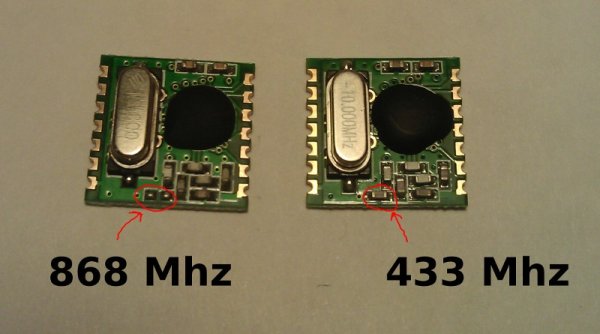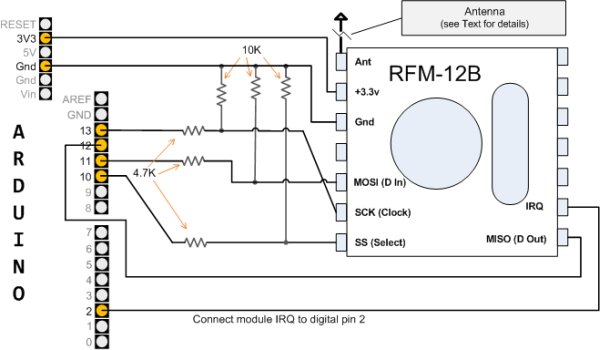To see how RFM12B wireless compares to other similar wireless options (e.g Xbee, XRF etc..) check out this well compiled comparison overview by Stuart Poulton: http://blog.homelabs.org.uk/wireless-connectivity/.
Overview
Made by Hope RF, re-branded by RFsolutions in the UK. Sometimes called ‘Alpha RF’
Low cost RF transceiver (from Rapid, Farnell, or RS in the UK)
Up to 300m transmission
Up to 115Kbps
Up to 30 nodes per network*
Up to 250 different network groups
3 different ISM band frequencies: 433MHz (worldwide), 868MHz (Europe), 915MHz (USA & Australia only) . Note: frequency of a module is set in software, for best performance the frequency set should match the intended hardware frequency of the module.
*node ID’s can be 0-31 with 1-30 used for normal use.
ID 31 is special as it can communicate with nodes on any network and ID 0 is reserved for OOK use
Hardware
SPI interface
2.2-3.8V supply voltage
Low power – 0.3µA standby current
Datasheet: http://www.hoperf.com/pro/rf/cob/RFM12B.htm
Identifying the frequency of your module
Includes additional capacitor = 433 MHz
Missing capactior = 868 MHz
Antenna
433 1/4 wave = 164.7mm
433 1/2 wave = 329.4mm
433 full wave = 692.7mm
868 1/4 wave = 82.2mm
868 1/2 wave = 164.3mm
868 full wave = 345.5mm
915 1/4 wave = 77.9mm
915 1/2 wave = 155.9mm
915 full wave = 327.8mm
Credit to Michael Margolis from Arduino Cookbook for Arduino connection diagram.
Alternative connection diagram (only for when Atmega328 is running at 3.3V):
Update: Arduino Leonardo (ATmega32U4) requires different connections. See this blog post for details.
Software
Code example: https://github.com/openenergymonitor/RFM12B_Simple
RFM12 Arduino library from JeeLabs: https://github.com/jcw/jeelib – credit to JCW for this great work
See this post by JCW describing the Nodes, Addresses and operation of the JeeLib RFM12 Arduino Library: http://jeelabs.org/2011/01/14/nodes-addresses-and-interference/
JeeLib library reference: http://jeelabs.net/pub/docs/jeelib/RF12_8cpp.html
For more detail: RFM12B – Part 1 – Hardware Overview


